The Ghostly Tales of York
With over five hundred reports of spooky happenings within our ancient walls, the International Ghost Research Foundation has declared York to be the most haunted city in Europe. Well, when I heard that, I just had to write a book that included some of the city’s most famous ghost stories. A Ghostly Shadow, the third Chief Inspector Shadow Mystery takes place at Halloween and involves several of York’s ghost walkers, the men and women who guide visitors around the city and entertain them with scary and gruesome tales.
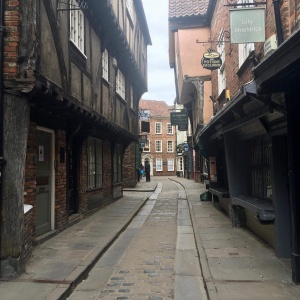
Shambles
Two of my ghost walk guides dress up as York’s most infamous sons, Guy Fawkes and Dick Turpin, who are both said to haunt the city. Guy Fawkes was born in York. He was a Catholic at a time when King James, a Protestant, was on the throne. Desperate to return the country to the ‘true faith’, Fawkes and his fellow conspirators hatched a plot to blow up the Houses of Parliament and assassinate the king in November 1605. However, they were betrayed and Fawkes was arrested next to the gunpowder in the cellars beneath the Palace of Westminster. After being tortured in the Tower of London, he was put to death as a traitor. Now every November 5th we celebrate this event with fireworks and burning effigies of Guy on bonfires. Please note, the only place that does not celebrate is York’s St Peter’s School where Guy was educated – they think it’s bad form to burn an old boy!
A hundred years later, Dick Turpin, the notorious highwayman, suffered a violent death too. Originally from the south of England, he was a thief, who killed a gamekeeper then ran away to York and changed his name to John Palmer. While here, he was arrested for stealing a chicken. From prison he wrote to his family, but by a cruel twist of fate, the postman who delivered the letter was the man who taught Dick to write and recognised his handwriting. When his true identity was revealed, Dick was hanged on the Knavesmire and afterwards his body was put on display in the cellar of the Blue Boar on Castlegate. A replica of his coffin is still there today!
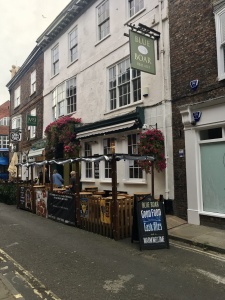
Blue Boar Inn
Perhaps our most famous ghost story takes place at the Treasurer’s House. Originally built to house the man in charge of the Minster’s finances, it eventually became a private home. In the 1950’s, Harry Martindale, an apprentice plumber, was working alone in the cellar. He could hear the sound of a horn being blown, but assumed it was a radio on upstairs. Then he heard the sound of horse’s hooves and a huge carthorse suddenly emerged through the wall behind him. On the horse’s back was a Roman soldier. Harry fell from his ladder in horror and watched as the horse was followed by a procession of other soldiers. Unlike the Hollywood depiction of Romans in red and gleaming gold uniforms, these soldiers were dirty, dishevelled and dressed in green. He could also only see them from the knees up. When telling his story to historians from the university, they confirmed that his description of the soldiers was accurate for the legions who were based in York, but the details he gave were unknown outside academic circles. They also explained that the Via Decumana, the original Roman Road, was buried fifteen inches beneath the cellar floor which was why their lower legs were not visible.
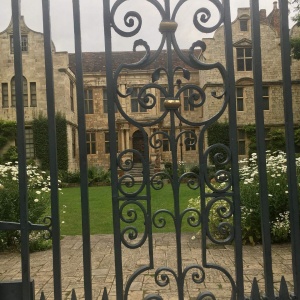
Treasurer’s House
Not far from the Minster and Treasurer’s House, stands the Plague House. The bubonic plague arrived in London in 1665 and soon spread north. A little girl was bricked up inside the house with her parents who had symptoms of the deadly disease, to prevent further contamination. Although she didn’t have the plague herself, the little girl was left to die, with no food or water. Since then, her tear-stained face has been spotted staring out of the window.
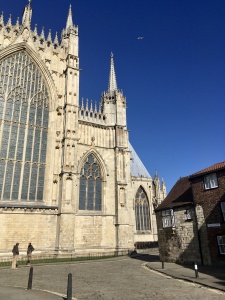 The Plague House in the shadow of the Minster
The Plague House in the shadow of the Minster
Those of you who have read A Long Shadow, the first book in my series, may remember that a victim was discovered in Bedern next to one of Shadow’s favourite Italian restaurants. Bedern means college or house of prayer in Anglo-Saxon. It was once home to the Minster’s choral scholars. All that now remains is Bedern Hall, the old refectory or dining room. In the nineteenth century, Bedern Hall was used as a school and workhouse for the city’s orphans. It was run by a man named Pimm, who was more concerned with the money he could make than the welfare of the children in his care. Many of those in his care died of starvation. At first, he buried their bodies but when winter came and the ground became hard, he hid them in a cupboard. Soon the guilt and his drinking drove Pimm mad. His crimes were discovered and he was taken to an asylum. Today it is still claimed that as you walk along Bedern you can hear the sound of children playing, but if you stop and listen, their laughter soon turns to screams.
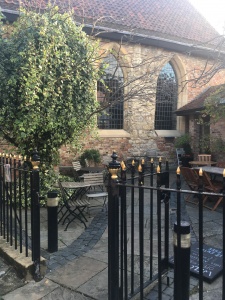 Bedern Hall today
Bedern Hall today
I hope you’ve enjoyed these ghostly tales of York. If you have, why not come and find me on Facebook where I often post about the weird and wonderful happenings in my home city.
Happy Halloween!
About the Author
 H L Marsay always loved detective stories and promised herself that one day, she would write one too. She is lucky enough to live in York, a city full of history and mystery. When not writing, the five men in her life keep her busy – two sons, two dogs and one husband.
H L Marsay always loved detective stories and promised herself that one day, she would write one too. She is lucky enough to live in York, a city full of history and mystery. When not writing, the five men in her life keep her busy – two sons, two dogs and one husband.






